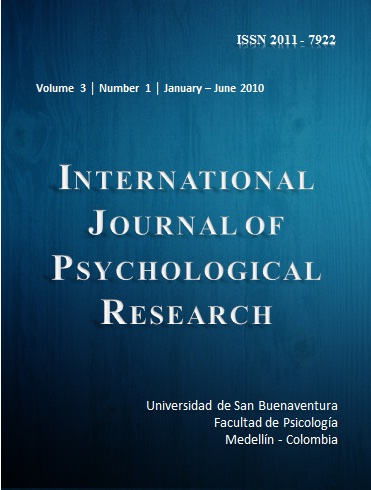How to Cite
An Hsieh, C., & von Eye, A. (2010). The best of both worlds: a joint modeling approach for the assessment of change across repeated measurements. International Journal of Psychological Research, 3(1), 176–207. https://doi.org/10.21500/20112084.862
More Citation Formats
License terms
▼
The work that is sent to this journal must be original, not published or sent to be published elsewhere; and if it is accepted for publication, authors will agree to transfer copyright to International Journal of Psychological Research.
To give up copyright, the authors allow that, International Journal of Psychological Research, distribute the work more broadly, check for the reuse by others and take care of the necessary procedures for the registration and administration of copyright; at the same time, our editorial board represents the interests of the author and allows authors to re-use his work in various forms. In response to the above, authors transfer copyright to the journal, International Journal of Psychological Research. This transfer does not imply other rights which are not those of authorship (for example those that concern about patents). Likewise, preserves the authors rights to use the work integral or partially in lectures, books and courses, as well as make copies for educational purposes. Finally, the authors may use freely the tables and figures in its future work, wherever make explicit reference to the previous publication in International Journal of Psychological Research. The assignment of copyright includes both virtual rights and forms of the article to allow the editorial to disseminate the work in the manner which it deems appropriate.
The editorial board reserves the right of amendments deemed necessary in the application of the rules of publication.
To give up copyright, the authors allow that, International Journal of Psychological Research, distribute the work more broadly, check for the reuse by others and take care of the necessary procedures for the registration and administration of copyright; at the same time, our editorial board represents the interests of the author and allows authors to re-use his work in various forms. In response to the above, authors transfer copyright to the journal, International Journal of Psychological Research. This transfer does not imply other rights which are not those of authorship (for example those that concern about patents). Likewise, preserves the authors rights to use the work integral or partially in lectures, books and courses, as well as make copies for educational purposes. Finally, the authors may use freely the tables and figures in its future work, wherever make explicit reference to the previous publication in International Journal of Psychological Research. The assignment of copyright includes both virtual rights and forms of the article to allow the editorial to disseminate the work in the manner which it deems appropriate.
The editorial board reserves the right of amendments deemed necessary in the application of the rules of publication.
Abstract
The usefulness of Bayesian methods in estimating complex statistical models is undeniable. From a Bayesian standpoint, this paper aims to demonstrate the capacity of Bayesian methods and propose a comprehensive model combining both a measurement model (e.g., an item response model, IRM) and a structural model (e.g., a latent variable model, LVM). That is, through the incorporation of the probit link and Bayesian estimation, the item response model can be introduced naturally into a latent variable model. The utility of this IRM-LVM comprehensive framework is investigated with a real data example and promising results are obtained, in which the data drawn from part of the British Social Attitudes Panel Survey 1983-1986 reveal the attitude toward abortion of a representative sample of adults aged 18 or older living in Great Britain. The application of IRMs to responses gathered from repeated assessments allows us to take the characteristics of both item responses and measurement error into consideration in the analysis of individual developmental trajectories, and helps resolve some difficult modeling issues commonly encountered in developmental research, such as small sample sizes, multiple discretely scaled items, many repeated assessments, and attrition over time.
Keywords:
Downloads
Download data is not yet available.


































